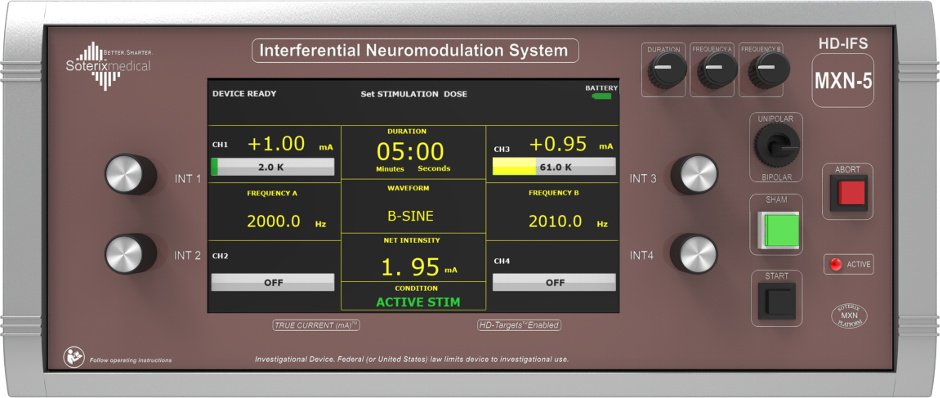
The only integrated device and accessory set for clinical research on interferential (IF) for temporal interference (TI) non-invasive brain stimulation.
About Interferential or Temporal Interference Stimulation
Interferential Stimulation (IF) is the simultaneous application of two sine waves of high but slightly different frequencies via two pairs of electrodes or two current sources. The addition of two high frequency (HF) sine waves of slightly different frequencies results in a waveform that is a carrier-wave (average of the two sine waves) modulated by a low frequency envelope oscillating at a “beat” frequency. This beat frequency is the difference of the frequencies of the two sinusoids (figure below). It is known that neurons due to their intrinsic low-pass filtering do not respond to high frequencies (i.e. > 100 Hz).
High Frequency (HF) or High Rate (HR) stimulation is the use of frequencies at 1 kHz or above. HF / HR approaches like IF /TI stimulation are among the most exciting in electrotherapy (including neuromodulation, brain stimulation, rehabilitation, and bio-electric medicine) because they produce distance effects on the body compared to the conventional (100 Hz and lower) stimulation frequencies. Clinically, these differences can span unique therapeutic benefits as well as distinct side-effect benefits. Precisely because HF / HR interventions operate at frequency range well above conventional frequencies, it is also believed HF / HR stimulation engage unique cellular targets and mechanisms.
For several decades (usage reviewed in Pope et al, 1995 and more recently in Shah and Farrow, 2012), this principle has been used in non-invasive electrical stimulation called Interferential Therapy (IF) or more recently called Temporal Interference (TI) stimulation (Grossman et al, 2017). For a broad historical review ,see Guleyupoglu 2013. The use of IF/TI for medical stimulation dates to at least the 1970’s (Brown, 1975) but still earlier applications in Russia (erstwhile USSR) have been reported.
As such, understanding and characterizing HF / HR stimulation remains an important question. Therefore any research involving this technique critically depends on the use of stimulators that can reproduce HF / HR waveforms with precision.

References
Electroanesthesia and electrosleep Brown CC, (1975)
A Survey of Electrotherapeutic Modalities: Ownership and Use in the NHS in England Pope GD, Mockett SP, Wright JP (1995)
Trends in the availability and usage of electrophysical agents in physiotherapy practices from 1990 to 2010: a review Shah S, Farrow A (2012)
Classification of methods in transcranial electrical stimulation (tES) and evolving strategy from historical approaches to contemporary innovations. Guleyupoglu B, Schestatsky P, Edwards D, Fregni F, Bikson M. (2013)
Noninvasive Deep Brain Stimulation via Temporally Interfering Electric Fields. Grossman N, Bono D, Dedic N, Kodandaramaiah SB, Rudenko A, Suk HJ, Cassara AM, Neufeld E, Kuster N8, Tsai L, Pascual-Leone A, Boyden ES. (2017)
To request for more information or quotation about the Interferential Neuromodulation Device, please click here.
